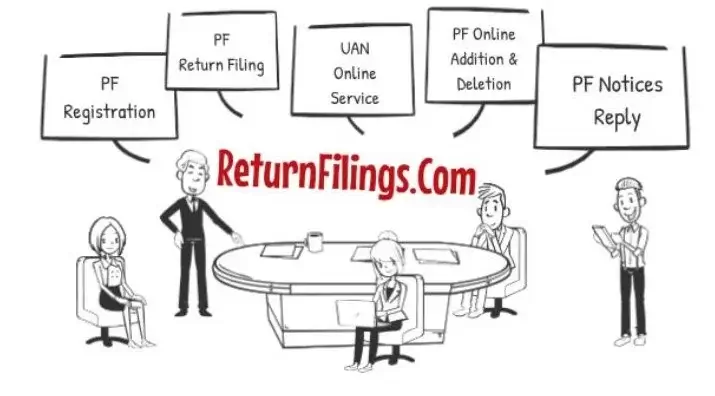PF and ESI Compliance for Indian Employers: Filing, Penalties & Unified Portal
1. Introduction
Provident Fund (PF) and Employees’ State Insurance (ESI) are two crucial social security schemes for employees in India. Every employer covered under these schemes must comply with their monthly and annual filing requirements, this PF and ESI Compliance is essential for Indian Employers
• Provident Fund (PF) is governed by the Employees’ Provident Fund & Miscellaneous Provisions Act, 1952 and managed by the Employees’ Provident Fund Organization (EPFO).
• Employees’ State Insurance (ESI) is governed by the Employees’ State Insurance Act, 1948, and regulated by the Employees’ State Insurance Corporation (ESIC).
Employers need to comply with monthly, quarterly, and annual return filing requirements, including timely deposits and updates related to new and exited employees.
2. Employees’ Provident Fund (EPF) Compliance
2.1 Who Needs to Register for PF?
• Any establishment with 20 or more employees must register for PF.
• Employees earning up to ₹15,000 per month must compulsorily contribute to PF.
• Employees earning above ₹15,000 can opt-out of PF if they are not contributing at the time of joining.
2.2 Monthly PF Returns & Timelines
| Form Name | Purpose | Due Date | Filing Mode |
|---|---|---|---|
| ECR (Electronic Challan cum Return) | Monthly contribution details of employees | 15th of every month | EPFO Portal |
| Form 5A | Details of the employer’s ownership and compliance officer | At the time of registration | EPFO Portal |
| Form 10 | Details of exited employees | Monthly | EPFO Portal |
| Form 2 (Nomination Form) | Employee nomination details | At the time of joining | EPFO Portal |
| Form 11 | Declaration form for new employees joining PF for the first time | At the time of joining | EPFO Portal |
2.3 PF Contribution Rates
| Contributor | Percentage of Basic Salary |
|---|---|
| Employee Contribution | 12% of Basic Salary |
| Employer Contribution | 12% (8.33% to EPS & 3.67% to EPF) |
| Total Contribution | 24% of Basic Salary |
2.4 Employee Inclusions & Exclusions
| Category | Included in PF? |
|---|---|
| Employees earning up to ₹15,000/month | Yes (Mandatory) |
| Employees earning above ₹15,000/month | Optional (If already enrolled, must continue) |
| Apprentice (under Apprentices Act) | No |
| Contract employees (if PF deducted by contractor) | Yes |
2.5 PF Return for New & Exited Employees
• New Employees: Employers must submit Form 11 for newly joined employees and ensure they are covered under PF.
• Exited Employees: Employers must file Form 10 to report employees who have left the organization.
3. Employees’ State Insurance (ESI) Compliance
3.1 Who Needs to Register for ESI?
• Establishments with 10 or more employees (20 in some states) must register for ESI.
• Employees earning ₹21,000/month or below must mandatorily contribute to ESI.
• ESI benefits cover medical, disability, maternity, and dependent benefits.
3.2 Monthly ESI Returns & Timelines
| Form Name | Purpose | Due Date | Filing Mode |
|---|---|---|---|
| ESI Contribution File (Online Return) | Monthly ESI contribution details | 15th of every month | ESIC Portal |
| Form 1 | Declaration form for new employees | At the time of joining | ESIC Portal |
| Form 3 | Employer’s details (Registration Form) | Once during registration | ESIC Portal |
| Form 6 | Monthly Register of Employees | Ongoing | ESIC Portal |
| Form 10 | Employees exiting from ESI coverage | Monthly | ESIC Portal |
3.3 ESI Contribution Rates
| Contributor | Percentage of Gross Salary |
|---|---|
| Employee Contribution | 0.75% |
| Employer Contribution | 3.25% |
| Total Contribution | 4% |
3.4 Employee Inclusions & Exclusions
| Category | Included in ESI? |
|---|---|
| Employees earning up to ₹21,000/month | Yes (Mandatory) |
| Employees earning above ₹21,000/month | No |
| Casual labor, trainees, interns (without stipend) | No |
| Contract employees (if ESI deducted by contractor) | Yes |
3.5 ESI Return for New & Exited Employees
• New Employees: Employers must file Form 1 to register new employees.
• Exited Employees: Employers must file Form 10 to remove employees who have left.
4. Penalties for Non-Compliance
Failing to comply with PF and ESI regulations can result in severe penalties.
| Non-Compliance | Penalty |
|---|---|
| Late PF Payment | 12% per annum interest |
| Late ESI Payment | 12% per annum interest |
| Delayed Return Filing | ₹5,000 penalty per return |
| False Declaration | ₹5,000 – ₹25,000 fine and possible imprisonment |
5. Unified PF and ESI compliance via Shram Suvidha Portal
Employers can file a single combined return for both PF and ESI compliance using the Shram Suvidha Portal (shramsuvidha.gov.in). This simplifies compliance and reduces duplication of filings.
Steps to File Combined PF & ESI Return:
a. Register on Shram Suvidha Portal.
b. Upload monthly data for both PF & ESI.
c. Generate a single Challan cum Return.
d. Make an online payment.
e. File return confirmation.
6. Conclusion
Proper PF and ESI compliance ensures legal adherence and avoids penalties. Employers must ensure timely return filing, correct employee inclusions/exclusions, and accurate salary deductions. Using the Shram Suvidha Portal can ease the compliance burden.
Would you like assistance in filing your PF & ESI returns or clarification on any specific compliance aspect? Let me know how I can help, by adhering to the above compliance requirements, avoid penalties, and maintain good legal standing. For professional assistance, reach out to us on email: info@returnfilings.com or on whatsapp: https://wa.me/919910123091 to ensure all statutory obligations are met on time.
frequently asked questions (faq's) related to PF and ESI Return Filing and Compliance
Q What is PF (Provident Fund)?+
A The Employees' Provident Fund (EPF) is a social security scheme managed by the Employees' Provident Fund Organisation (EPFO). It's a retirement savings scheme where both the employee and employer contribute a specified percentage of the employee's basic salary plus dearness allowance.
Q What is ESI (Employees' State Insurance)?+
A The Employees' State Insurance (ESI) scheme is a social security scheme managed by the Employees' State Insurance Corporation (ESIC). It provides medical benefits, sickness benefits, maternity benefits, disablement benefits, and dependents' benefits to employees earning up to a certain wage limit. Both the employee and employer contribute.
Q Who is covered under PF and ESI?+
A PF: Generally, employees earning up to ₹15,000 per month (basic + DA) in establishments covered under the EPF Act are eligible. Some establishments are exempt.
ESI: Employees earning up to ₹21,000 per month are covered under the ESI scheme.
Q What are the benefits of PF and ESI?+
A PF: Retirement savings, tax benefits, and financial security for employees.
ESI: Access to medical care, sickness benefits, maternity benefits, and other social security benefits.
Q What are the key PF forms and returns?+
A Key PF forms and returns include:
• ECR (Electronic Challan cum Return): A consolidated monthly return for contribution payment and employee details.
• Form 22A: Nomination and declaration form.
Q How often are PF returns filed?+
A PF returns (ECR) are filed monthly.
Q What is the due date for filing PF returns?+
A The due date for filing the ECR is the 15th of the following month.
Q What happens if an employer fails to file PF returns on time?+
A Late filing attracts penalties, which increase with the duration of the delay.
Q Where can I file PF returns?+
A PF returns are filed online through the EPFO portal.
Q What are the key ESI forms and returns?+
A Key ESI forms and returns include:
• ESI Return (Form 5): A consolidated return showing details of employees covered, contributions made, etc.
Q How often are ESI returns filed?+
A ESI returns (Form 5) are filed half-yearly.
Q What is the due date for filing ESI returns?+
A For the period April to September: November 15th
For the period October to March: May 15th
Q What happens if an employer fails to file ESI returns on time?+
A Late filing attracts penalties, which increase with the duration of the delay.
Q Where can I file ESI returns?+
A ESI returns are filed online through the ESIC portal.
Q What is the contribution rate for PF?+
A The standard PF contribution rate is 12% of the employee's basic salary plus dearness allowance, with both the employee and employer contributing equally. Some establishments may have a reduced rate of 10%.
Q What is the contribution rate for ESI?+
A The standard ESI contribution rate is 4% (3.25% employer and 0.75% employee) of the employee's gross wages, subject to the wage ceiling.
Q How are PF and ESI contributions paid?+
A PF and ESI contributions are paid online through the respective portals (EPFO and ESIC) using electronic challans.
Q How do I register my establishment with EPFO and ESIC?+
A You can register online through the respective portals (EPFO and ESIC). You'll need details of your establishment and employees.
Q What are the documents required for PF and ESI registration?+
A Documents typically include registration certificates, PAN, bank details, and employee details.
Q What is the process for generating PF and ESI challans?+
A Challans are generated online through the EPFO and ESIC portals after uploading the necessary information.
Q How do I update employee details in PF and ESI records?+
A Employee details are updated online through the respective portals.
Q What are the penalties for non-compliance with PF and ESI regulations?+
A Penalties include fines for late filing, non-payment of contributions, and other violations.
Q How do I calculate PF and ESI contributions?+
A PF is calculated as a percentage of basic salary plus DA. ESI is calculated as a percentage of gross wages, subject to the wage ceiling.
Q What are the benefits of online PF and ESI filing?+
A Online filing is more convenient, efficient, and reduces the risk of errors.
Q How can I track my PF and ESI payments?+
A You can track payments through the respective online portals.
Q What are the regulations regarding PF and ESI for contractual employees?+
A Contractual employees are also covered under PF and ESI if they meet the eligibility criteria.
Q Where can I find the latest PF and ESI notifications and circulars?+
A The EPFO and ESIC websites are the official sources for notifications and circulars.
- For further reading, explore the following topics:
- 📑 EPF Registration Process in India: Eligibility, Mandatory Documents & Online Application Guide
- 💼 Benefits & Responsibilities of ESI Registration for Employers in India: Complete Guide
- 🔄 Stepwise process for director resignation and ROC filing
- ❌ How to remove director disqualification in India

